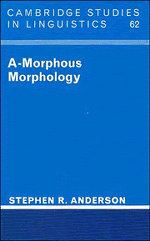Book contents
- Frontmatter
- Contents
- Acknowledgments
- Introduction
- 1 The study of word structure
- 2 Why have a morphology at all?
- 3 Is morphology really about morphemes?
- 4 The interaction of morphology and syntax
- 5 The theory of inflection
- 6 Some complex inflectional systems
- 7 Morphology in the lexicon: derivation
- 8 Clitics are phrasal affixes
- 9 The relation of morphology to phonology
- 10 How much structure do words have?
- 11 Composites: words with internal structure
- 12 Morphology and the typology of languages
- 13 Morphological change
- 14 Morphology as a computational problem
- References
- Index
3 - Is morphology really about morphemes?
Published online by Cambridge University Press: 10 January 2011
- Frontmatter
- Contents
- Acknowledgments
- Introduction
- 1 The study of word structure
- 2 Why have a morphology at all?
- 3 Is morphology really about morphemes?
- 4 The interaction of morphology and syntax
- 5 The theory of inflection
- 6 Some complex inflectional systems
- 7 Morphology in the lexicon: derivation
- 8 Clitics are phrasal affixes
- 9 The relation of morphology to phonology
- 10 How much structure do words have?
- 11 Composites: words with internal structure
- 12 Morphology and the typology of languages
- 13 Morphological change
- 14 Morphology as a computational problem
- References
- Index
Summary
As the discussion in chapter 1 showed, there are historical reasons for the fact that contemporary thought about word structure is so close to the position developed by American structuralist morphologists. In the early days of generative phonology and syntax, the assumptions of structuralists about the nature of words and their component parts were not so much attacked or embraced as ignored; and when morphology came to be studied again, these basic notions were simply taken over unexamined as defining the subject matter. In fact, however, the structuralist ontology was not just a simple and obvious set of postulates, but rather, a carefully constructed theory of word structure, arrived at after a great deal of discussion; and this theory presented notable problems, as recognized explicitly by its developers. We sketch its premises here for this reason, as well as because of the exemplary explicitness of structuralist theorizing about morphology.
Classical morphemes
The basic fact which a theory of word structure must account for is the observation that complex words show partial phonetic/semantic resemblances to one another. Thus, unreasonable-ness resembles red-ness, un-reasonable resembles un-true, reason-able resembles break-able, etc. It is this set of partial phonetic–semantic resemblances that suggests the decomposition un-reason-able-ness. The theory of morphology is basically an attempt to provide principled grounds for such an analysis.
The starting point for the structuralist discussion of such problems is Bloomfield (1933), whose goal was to provide a firm procedural basis for the analyses linguists arrive at.
- Type
- Chapter
- Information
- A-Morphous Morphology , pp. 48 - 72Publisher: Cambridge University PressPrint publication year: 1992



